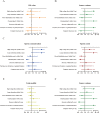Association of living environmental and occupational factors with semen quality in chinese men: a cross-sectional study
- PMID: 37735181
- PMCID: PMC10514289
- DOI: 10.1038/s41598-023-42927-z
Association of living environmental and occupational factors with semen quality in chinese men: a cross-sectional study
Abstract
Sperm quality can be easily influenced by living environmental and occupational factors. This study aimed to discover potential semen quality related living environmental and occupational factors, expand knowledge of risk factors for semen quality, strengthen men's awareness of protecting their own fertility and assist the clinicians to judge the patient's fertility. 465 men without obese or underweight (18.5 < BMI < 28.5 kg/m2), long-term medical history and history of drug use, were recruited between June 2020 to July 2021, they are in reproductive age (25 < age < 45 years). We have collected their semen analysis results and clinical information. Logistic regression was applied to evaluate the association of semen quality with different factors. We found that living environment close to high voltage line (283.4 × 106/ml vs 219.8 × 106/ml, Cohen d = 0.116, P = 0.030) and substation (309.1 × 106/ml vs 222.4 × 106/ml, Cohen d = 0.085, P = 0.015) will influence sperm count. Experienced decoration in the past 6 months was a significant factor to sperm count (194.2 × 106/ml vs 261.0 × 106/ml, Cohen d = 0.120, P = 0.025). Living close to chemical plant will affect semen PH (7.5 vs 7.2, Cohen d = 0.181, P = 0.001). Domicile close to a power distribution room will affect progressive sperm motility (37.0% vs 34.0%, F = 4.773, Cohen d = 0.033, P = 0.030). Using computers will affect both progressive motility sperm (36.0% vs 28.1%, t = 2.762, Cohen d = 0.033, P = 0.006) and sperm total motility (57.0% vs 41.0%, Cohen d = 0.178, P = 0.009). After adjust for potential confounding factors (age and BMI), our regression model reveals that living close to high voltage line is a risk factor for sperm concentration (Adjusted OR 4.03, 95% CI 1.15-14.18, R2 = 0.048, P = 0.030), living close to Chemical plants is a protective factor for sperm concentration (Adjusted OR 0.15, 95% CI 0.05-0.46, R2 = 0.048, P = 0.001) and total sperm count (Adjusted OR 0.36, 95% CI 0.13-0.99, R2 = 0.026, P = 0.049). Time spends on computer will affect sperm total motility (Adjusted OR 2.29, 95% CI 1.11-4.73, R2 = 0.041, P = 0.025). Sum up, our results suggested that computer using, living and working surroundings (voltage line, substation and chemical plants, transformer room), and housing decoration may association with low semen quality. Suggesting that some easily ignored factors may affect male reproductive ability. Couples trying to become pregnant should try to avoid exposure to associated risk factors. The specific mechanism of risk factors affecting male reproductive ability remains to be elucidated.
© 2023. Springer Nature Limited.
Conflict of interest statement
The authors declare no competing interests.
Figures
Similar articles
-
Body mass index in relation to semen quality and reproductive hormones in New Zealand men: a cross-sectional study in fertility clinics.Hum Reprod. 2013 Dec;28(12):3178-87. doi: 10.1093/humrep/det379. Epub 2013 Oct 15. Hum Reprod. 2013. PMID: 24129611
-
Association between adherence to the Mediterranean diet and semen quality parameters in male partners of couples attempting fertility.Hum Reprod. 2017 Jan;32(1):215-222. doi: 10.1093/humrep/dew288. Epub 2016 Nov 14. Hum Reprod. 2017. PMID: 27994040
-
Association of diet and lifestyle factors with semen quality in male partners of Chinese couples preparing for pregnancy.Reprod Health. 2023 Nov 23;20(1):173. doi: 10.1186/s12978-023-01718-5. Reprod Health. 2023. PMID: 37996913 Free PMC article.
-
Temporal trends in sperm count: a systematic review and meta-regression analysis of samples collected globally in the 20th and 21st centuries.Hum Reprod Update. 2023 Mar 1;29(2):157-176. doi: 10.1093/humupd/dmac035. Hum Reprod Update. 2023. PMID: 36377604
-
The effect of healthy dietary patterns on male semen quality: a systematic review and meta-analysis.Asian J Androl. 2022 Sep-Oct;24(5):549-557. doi: 10.4103/aja202252. Asian J Androl. 2022. PMID: 35915543 Free PMC article.
Cited by
-
Advancements in Genetic Biomarkers and Exogenous Antioxidant Supplementation for Safeguarding Mammalian Cells against Heat-Induced Oxidative Stress and Apoptosis.Antioxidants (Basel). 2024 Feb 20;13(3):258. doi: 10.3390/antiox13030258. Antioxidants (Basel). 2024. PMID: 38539792 Free PMC article. Review.
References
Publication types
MeSH terms
LinkOut - more resources
Full Text Sources
Miscellaneous


